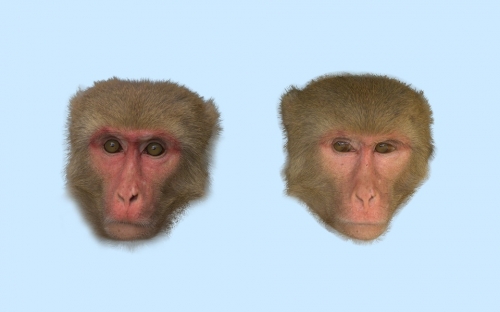研究成果 Research Results
- TOP
- News
- Research Results
- Primate trichromacy is well suited for detecting variation in facial coloration
Primate trichromacy is well suited for detecting variation in facial coloration
2017.07.07Research ResultsHumanities & Social SciencesLife & Health
Most primates including humans have trichromatic color vision that see colors by the set of three different cone photoreceptors: S (short) for blue, M (middle) for green, and L (long) for red. One puzzling feature of primate trichromacy is that the wavelength sensitivities of L and M cones are closely tuned (Fig. 1). One hypothesis has suggested that the primate vision might be especially good at detecting social signals such as facial coloration. The research group led by Chihiro Hiramatsu, an assistant professor of Kyushu University, Amanda Melin of the University of Calgary, and James Higham of New York University provided the first experimental evidence that the primate trichromacy is well suited for detecting variation in facial coloration. The group used photographs of female rhesus macaques whose face color becomes redder and darker during the reproductive period. The group presented pairs of faces of the same monkey to human observers and asked them to select the face taken during the reproductive period. The group compared the performance of human observers under different conditions, in which their perception was manipulated to simulate different color vision types. The results show that, when compared to other visual systems, the trichromatic color vision that primates exhibit confers an excellent ability to detect variations in facial coloration. “These results indicate the reason why we see subtle facial color changes in others such as blushing, which are socially informative signals,” says Hiramatsu.
For more information about this research, see rspb.royalsocietypublishing.org/lookup/doi/10.1098/rspb.2016.2458
Hiramatsu C, Melin AD, Allen WL, Dubuc C, Higham JP. “Experimental evidence that primate trichromacy is well suited for detecting primate social colour signals.”Proceedings of the Royal Society of London B, June 14, 2017(UK local time) DOI:10.1098/rspb.2016.2458)

Fig. 1.
Schematic illustration of the spectral sensitivities of S, M, and L cone photoreceptors in primates. The sensitivities of L and M cones are closely located at the longer part of the spectrum.

Fig. 2.
A face pair of a rhesus macaque female.
Left: a face taken during the reproductive period, right: face taken out of the reproductive period.
Journal Reference
Experimental evidence that primate trichromacy is well suited for detecting primate social colour signals, ,The journal Proceedings of the Royal Society Biological Sciences, 10.1098/rspb.2016.2458Research-related inquiries
- TOP
- News
- Research Results
- Primate trichromacy is well suited for detecting variation in facial coloration































